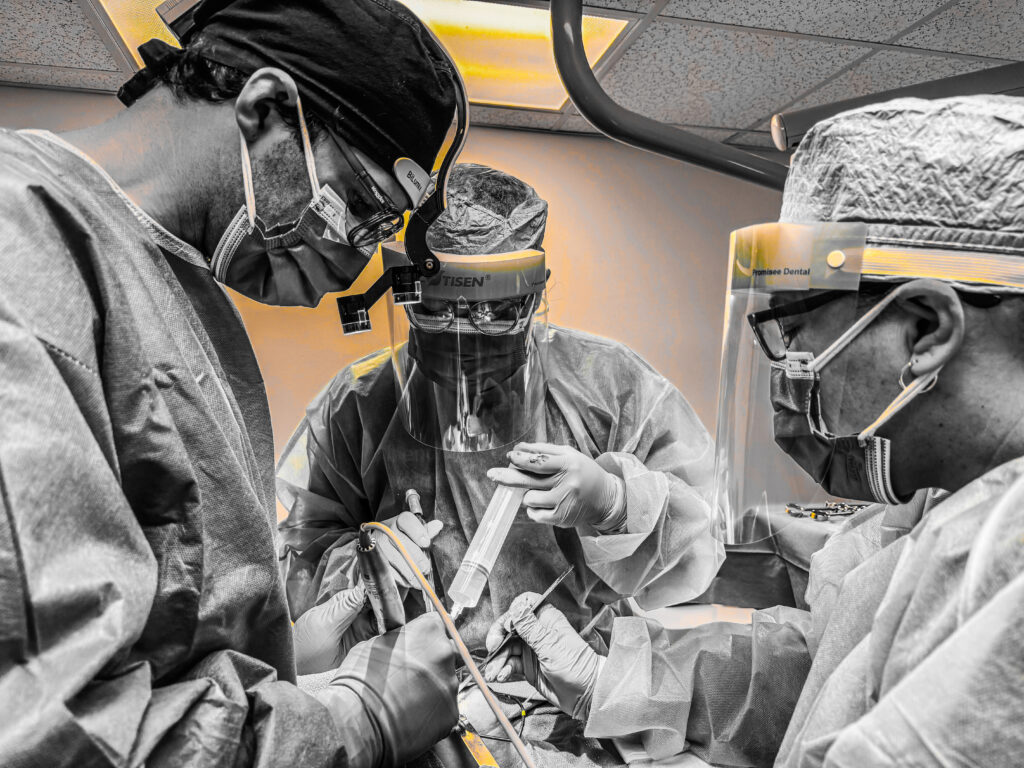There are many different surgical styles when it comes to where a surgeon positions themselves relative to the patient in order to complete different aspects of the AOX procedure.
I have been asked on more than one occasion if I “switch sides” during surgery to better visualize anatomy when operating. This discussion most commonly surfaces around the concept of the mental nerve and ensuring that the surgeon can clearly identify this structure and their implant angulation relative to it.
When my response is, “No, I never switch sides”, the next question is invariably, “Why not?”.
Well, wait no longer. Today, I’m going to answer that question.
6 Reasons Why I Don’t Switch Sides When I Operate
1. Switching sides is inefficient.
Switching back and forth from the patient’s right to left side, or vice versa, actually takes a lot of time.
Not only do you have to physically move yourself, but your team has to move as well.
Furthermore, you have to stop and pick up your visual focus on the surgical field, and then re-orient that focus from a new vantage point.
Simply put, this takes too much time.
2. Switching sides is hard on your surgical team.
As mentioned above, not only do you have to move, but your surgical team has to move and readjust too.
This may not seem like a big deal. But, if your team is set up for efficiency they should have all the instruments you will need strategically laid out in an order that is easy for them to access from their working side – so that they can pass them to you.
This all changes when you change sides.
In addition, the assistant loading and passing implants now has to pass your implants behind your chairside assistant and over the patient in order to reach you on the contralateral side.
This is inefficient and creates a surgical setup where it is harder for your assistants to perform at an optimal level.
3. Switching sides is difficult because, depending on your OR layout, the drill cord may not easily stretch to the off side.
Now, you may have your drill positioned so that it comes from directly behind the patient. If this is the case, then this may not apply to you.
My drill, however, is set up on the right side of the patient (right handed surgeon). Why? Because I don’t load my own drills or implants and the right side provides the assistant the best access to the drill, while also being able to easily pass the drill to my right hand.
In this scenario then, if I were to switch to the left side, that drill cord has to be stretched across the patient.
This is not desirable as it can create contact with a non-sterile portion of the drill cord onto the surgical field (the draped chest of the patient). It also creates a tension in the cord when drilling which I feel inhibits tactile sensation.

4. Switching sides isn’t necessary if you learn the look and feel of proper implant angulation from your primary side.
If you operate from one side, guess what? You will learn how proper implant angulation and position (at all sites) look from that side. You will adapt. The only time you won’t have this skill – is if you constantly change sides.
Now, I will admit that I lean my head over to a more 1 o’clock position when accessing implant site #20 (my off side). But I maintain my surgical stance and position on the right side of the patient. Over time I have learned what 30 degree angulation and an appropriate proximity to the mental foramen look like from this vantage point. You will too…
5. Switching sides isn’t necessary if you trust and rely on your team.
If there is a situation where I am truly worried about angulation or proximity, I will ask my chairside surgical assistant if their direct line of vision indicates any impingement on the mental foramen. You want your assistants to be comfortable and familiar with what a “normal” implant angulation and position looks like. They can then be another set of eyes when things are “off”.
6. Finally, “Embrace the lean and avoid the shuffle”.
Ok, ok. I do lean over very quickly to check my implant position on my off side. But this is just a lean of the head to improve visualize access. My feet and body stay on the right side of the patient. There is no shuffling of positions with the assistants. This “lean” takes only a few seconds.
Can you argue that all of these things are just me being “nit-picky”. Yes you can. But when performing this surgery at a high level with optimal surgical flow – these little details all matter. Switching sides simply has too many negative attributes that offset any positives. In my opinion, switching sides prevents a well oiled, finely tuned surgery.
Here’s to embracing the lean.
Matthew Krieger DMD
P. S. For clarity, I do operate between the 7 and 12 o’clock positions depending on which part of the AOX procedure I am performing. However, I never actually switch sides.

